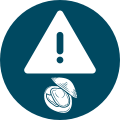
Our vision:
A safe and healthy Kitsap County for all.
Water Pollution Identification & Correction
The Kitsap Public Health District's Water Pollution Identification & Correction (PIC) program protects public health and prevents fecal pollution in Kitsap County surface waters.
Health District staff sample dozens of streams and swimming beaches across the county for fecal bacteria, an indicator of fecal pollution caused by human or animal waste. Fecal pollution can carry viruses and harmful bacteria that make people sick.
We use water sampling results to notify the public of potential health risks, and to find and fix fecal pollution problems. This helps keep our streams, swimming beaches and shellfish beds safe and healthy for the public to enjoy.
Read the 2025 Water Quality Monitoring Report
Protecting Our Surface Waters
Our Pollution Identification & Correction (PIC) water quality program is nationally recognized for its innovation and effectiveness. Our job is to ensure that surface waters are safe and sanitary, so you don't get sick when you swim in them or eat local shellfish.
Our work on your behalf includes:
Collecting water and shellfish samples to look for health threats;
Posting and publicizing warnings if a problem is identified;
Investigating to identify the source of pollution problems; and
Taking steps to correct problems.
Water Pollution Identification & Correction (PIC)
The mission of the PIC program, which started in 1993, is to protect the public from waterborne illness and other water quality-related hazards. Water that is polluted with fecal bacteria is our primary concern. Fecal bacteria can cause serious illness and detecting it can help prevent contact with other harmful pathogens such as viruses.
Looking For Trends
At the watershed scale, we monitor long-term water quality trends for Kitsap County's streams, lakes, and marine (salt) waters, known as surface waters. All Kitsap streams eventually flow into the Puget Sound or Hood Canal. This means polluted streams can impact marine waters. Signs of pollution appear early but damage occurs more quickly because our streams are relatively small.
Early Warnings
Surface water quality provides early warning signs that development, land uses, and other human activities are beginning to harm the public's health, our shellfish resources, and the environment.
The primary sources of pollution in Kitsap are:
Failing septic and sewer systems;
Faulty stormwater systems;
Pet and livestock waste;
Runoff from farms; and,
Wildlife.
Addressing Pollution
Each year our PIC team uses monitoring data to prioritize the waterways that are most impacted by fecal pollution. We investigate potential sources of pollution based on priority. When we locate the source, we work closely with property owners to reduce or eliminate it.
We use many tools to address pollution such as education and outreach, connecting property owners to resources, and occasionally enforcement is used as a last resort.
RV Waste Disposal
Because RV wastewater can make people sick, it must be handled and disposed of properly. Please contact us at (360) 728-2235 if you have any questions or read this fact sheet about RV Waste.
Water Quality Reports
We publish annual reports about our ongoing efforts to improve water quality, including the current priority list of polluted areas and results for areas we have already improved.
Responding to Sewage Spills
To ensure public safety, we respond around the clock to any report of a sewage spill or leak from a publicly owned sewer system. System operators are required to report spills to PIC as soon as they occur. We assess potential danger to public health. If we determine risk exists, we issue a no-contact advisory for the affected waters and notify the public on our website, through social media, our email list serve, and local media. We then ensure the affected area is cleaned by the operator and according to policy. Before the advisories are lifted, we ensure the threat to public health is over.
Education
The work of public health centers on prevention. This means an important part of our job is to ensure that you have the information necessary to do your part in helping to prevent water pollution. We meet with property owners one on one and in a classroom setting to discuss the how to keep our waterways clean and healthy.
Our Partners
We coordinate our efforts with other agencies through the Clean Water Kitsap (CWK) partnership. CWK was created to reduce flooding, prevent pollution, and restore fish habitat through stormwater management activities. The ongoing efforts of these federal, state, and local partner agencies help us in our efforts to improve water quality in Kitsap County.
Current Advisories
Active swimming beach, cyanobacteria (blue-green algae), and sewage spill advisories are listed below. Visit our swimming beach monitoring page to learn more and see a list of the beaches we monitor. For shellfish advisories, see our shellfish safety page.

Swimmer's Itch
Location:
All Lakes
Start Date:
Status:
Active
Swimmer's Itch (cercarial dermatitis) is caused by an allergic reaction to a parasite.
Swimmers should wear waterproof sunscreen and shower or vigorously towel-off immediately after swimming in a lake.
This list displays water contact advisories that were removed (expired) in the current calendar year. These advisories are no longer in effect. Check the list above for active advisories.
Dyes Inlet
Advisory:
Sewage Spill Advisory
Start Date:
November 3, 2025
Date Removed:
November 10, 2025
Status:
Removed
Port Washington Narrows
Advisory:
Sewage Spill Advisory
Start Date:
October 2, 2025
Date Removed:
October 9, 2025
Status:
Removed
Long Lake
Advisory:
Swimming Beach Closure
Start Date:
August 20, 2025
Date Removed:
August 22, 2025
Status:
Removed
Kitsap Lake
Advisory:
Cyanobacteria Warning
Start Date:
August 8, 2025
Date Removed:
December 16, 2025
Status:
Removed
Island Lake
Advisory:
Swimming Beach Closure
Start Date:
June 11, 2025
Date Removed:
June 13, 2025
Status:
Removed
Portion of Liberty Bay/Keyport shoreline
Advisory:
Sewage Spill Advisory
Start Date:
April 30, 2025
Date Removed:
May 7, 2025
Status:
Removed















.png)
